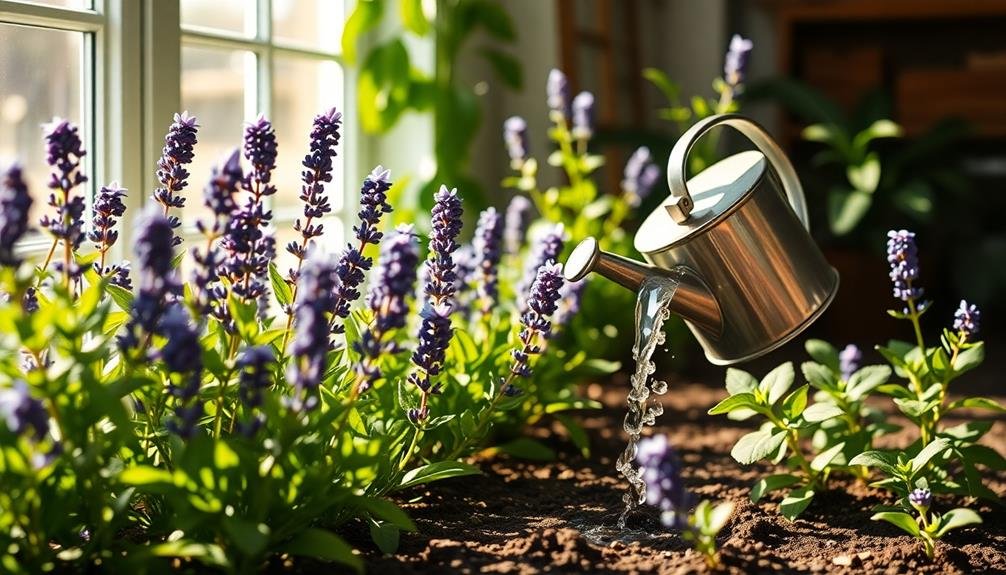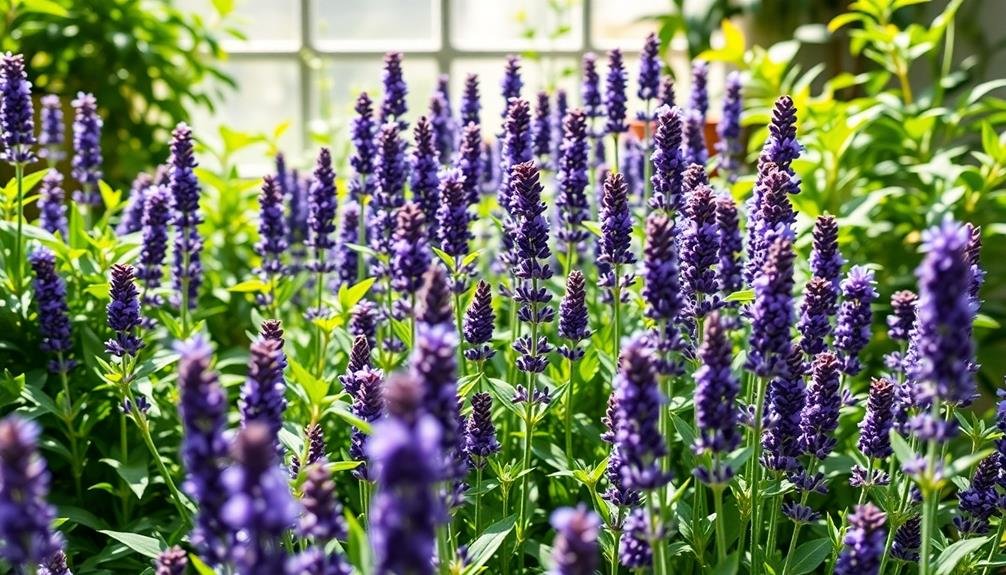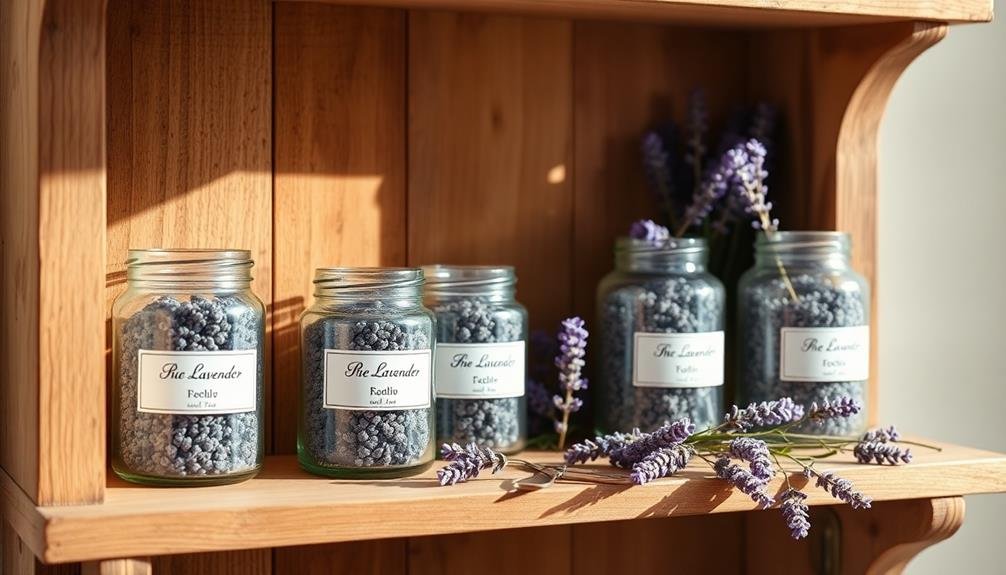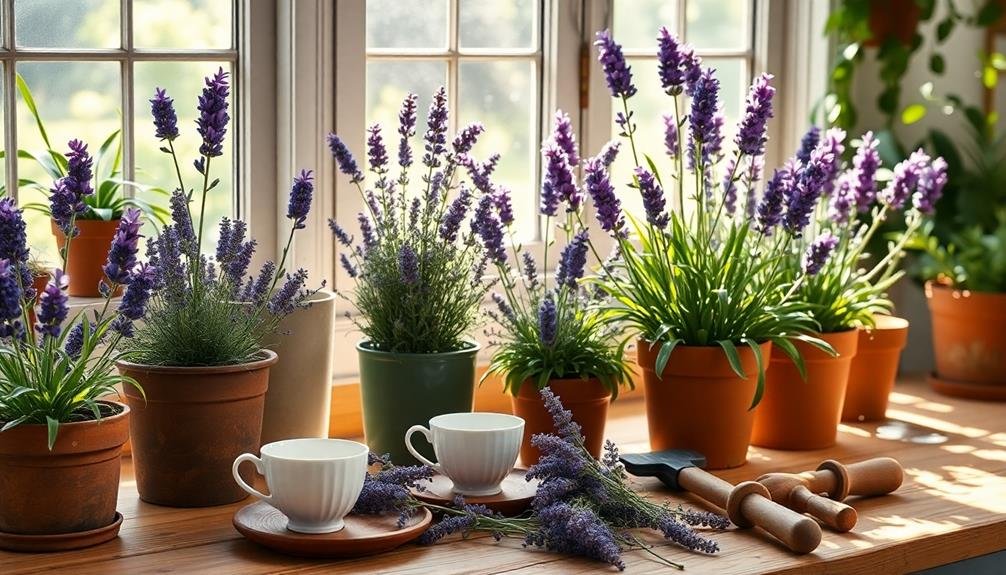To master indoor lavender, start by choosing compact varieties like 'Hidcote' or 'Munstead' that thrive in pots. Aim for 6-8 hours of bright, indirect sunlight daily, and keep the temperature between 65°F and 75°F. Use well-draining, slightly alkaline soil, and allow it to dry out between watering to prevent root rot. When harvesting for tea, cut stems just as the buds begin to open for the best flavor. Properly dry your lavender by hanging bundles in a dark, well-ventilated area. Follow these tips, and you'll discover even better ways to enhance your tea garden!
Choosing the Right Lavender Variety

When it comes to choosing the right lavender variety for indoor growing, you'll find that not all types are created equal. Some varieties thrive indoors, while others may struggle with the limited space and light.
For indoor gardening, consider selecting compact types like 'Hidcote' or 'Munstead.' These varieties don't grow too tall, making them ideal for pots on windowsills or shelves.
You'll want to avoid larger varieties, such as 'Spanish Lavender' or 'French Lavender,' as they can become unruly and require more space than you can provide indoors.
Additionally, look for varieties that have a more aromatic quality, as you'll want to enjoy the fragrance while nurturing your plants.
Check the growth habit—some lavenders are bushy, while others are more upright. Depending on your indoor space, you can choose a shape that fits your aesthetic.
Finally, consider your climate; if you live in a cooler area, opt for hardier types like 'English Lavender' that can handle fluctuations in temperature.
Optimal Indoor Growing Conditions
Selecting the right lavender variety is just the beginning; creating ideal indoor growing conditions is essential for your plants' success.
First, you'll want to guarantee your lavender gets plenty of sunlight. Aim for at least 6-8 hours of bright, indirect light daily. A south-facing window is often the best spot, but you can also use grow lights if natural light is limited.
Next, keep an eye on temperature. Lavender thrives in warm environments, ideally between 65°F and 75°F during the day and slightly cooler at night. Avoid placing your plants near drafts or heat sources, as sudden temperature changes can stress them.
Humidity is another factor to take into account. Lavender prefers drier air, so avoid overly humid rooms. Good air circulation is key—think about using a small fan if your space tends to retain moisture.
Lastly, be mindful of watering. Overwatering can lead to root rot, so let the soil dry out between waterings. Check the moisture level by sticking your finger into the soil an inch deep; if it's dry, it's time to water.
Soil Requirements for Lavender

To grow healthy indoor lavender, you need to focus on the right soil composition.
Well-draining soil is essential, as lavender doesn't like sitting in water.
Additionally, keep an eye on the pH level, aiming for a slightly alkaline range to help your plants thrive.
Ideal Soil Composition
Finding the right soil composition is essential for growing healthy lavender. Lavender thrives in well-draining, nutrient-poor soils that mimic its natural habitat. Here's what you should aim for when preparing your soil:
- Texture: Use a mix of sandy and loamy soil to guarantee proper aeration.
- pH Level: Aim for a slightly alkaline pH, ideally between 6.5 and 7.5.
- Organic Matter: Incorporate minimal organic matter, as too much can retain moisture, which lavender doesn't like.
When you create an ideal soil environment, your lavender will flourish indoors. Avoid heavy soils, as they can lead to root rot and other health issues.
You can achieve the right composition by blending potting soil with sand or perlite to improve drainage and mimic the dry conditions lavender loves. If you're using store-bought soil, look for mixes specifically designed for cacti or succulents, as they typically have the right balance.
Drainage Importance
Proper drainage is essential for the health of your indoor lavender plants. Lavender thrives in well-draining soil, which prevents water from pooling around the roots. When roots sit in excess moisture, they can rot, leading to a decline in plant health or even death.
To guarantee proper drainage, choose a pot with drainage holes and fill it with a suitable soil mix. A combination of potting soil, sand, and perlite works wonders for lavender. The sand and perlite help create air pockets, allowing excess water to escape while retaining some moisture for the plant's needs.
Avoid using regular garden soil, as it often retains too much water and can suffocate your lavender.
When watering, always check the top inch of soil; if it's dry, it's time to water. If it's still moist, hold off for a few days. This practice not only prevents overwatering but also encourages healthy root development.
Ph Level Preferences
Lavender prefers a slightly alkaline soil with a pH level between 6.5 and 7.5. Getting this right is essential for healthy growth and vibrant blooms. If your soil is too acidic, you may notice stunted growth and fewer flowers.
You can easily test your soil's pH using a simple soil test kit from a garden center.
To adjust your soil's pH, consider these options:
- Add lime: Incorporating agricultural lime can raise the pH level, making the soil more alkaline.
- Use alkaline fertilizers: Some fertilizers are designed to promote a higher pH, providing nutrients while balancing acidity.
- Mix with alkaline amendments: Adding materials like crushed oyster shells or wood ash can help maintain the desired pH level.
Regularly checking your soil's pH will guarantee it stays within the ideal range. If you find it outside this range, don't hesitate to make adjustments.
Providing the right pH level won't only enhance your lavender's growth but also improve its fragrance and flavor, making your indoor herb garden a delightful success!
Potting Techniques for Success
Successful potting techniques are essential for nurturing indoor lavender and guaranteeing it thrives in your home. Start by choosing the right pot; it should have drainage holes to prevent waterlogging. Opt for a pot that's slightly larger than the root ball, allowing room for growth without overwhelming the plant.
Use a well-draining potting mix, ideally a blend designed for herbs or cacti. This will provide the necessary aeration and drainage that lavender needs. When potting, gently loosen the roots if they're tightly bound, but avoid excessive disturbance.
Place your lavender in the center of the pot and fill in around it with the potting mix, pressing lightly to eliminate air pockets.
Position your pot in a spot where it receives plenty of sunlight, as lavender thrives in bright light. If you're using a decorative outer pot, make sure it doesn't restrict drainage.
Watering Practices to Follow

When it comes to watering your indoor lavender, managing soil moisture is key to its health.
You'll need to establish a watering frequency that keeps the soil slightly dry between sessions.
Let's explore how to strike the right balance for your plant's thriving growth.
Soil Moisture Management
To guarantee your indoor lavender thrives, managing soil moisture is vital. Lavender prefers well-draining soil that allows excess water to escape, preventing root rot. Here are some key practices to implement:
- Check Drainage: Confirm your pot has drainage holes. This prevents water from pooling at the bottom, which can suffocate roots.
- Use the Right Soil: Opt for a sandy or gritty soil mix specifically designed for herbs or cacti. This allows for better moisture control and aeration.
- Monitor Moisture Levels: Use your finger to check soil moisture. If the top inch feels dry, it's time to water. Avoid overwatering, as lavender thrives in drier conditions.
Additionally, consider the humidity levels in your home. If you notice your lavender wilting, it might be a sign of underwatering, but yellowing leaves typically indicate overwatering.
Balancing these factors is vital to keeping your indoor lavender healthy. With attentive soil moisture management, you'll enjoy a flourishing lavender plant that enhances your tea herb garden beautifully.
Watering Frequency Guidelines
Finding the right watering frequency for your indoor lavender is just as important as managing soil moisture. Lavender thrives in well-drained soil, so you'll want to avoid overwatering. Generally, watering every two to three weeks is a good starting point, but this can vary based on your environment.
Check the top inch of the soil; if it feels dry, it's time to water. When you do, water thoroughly until it drains from the bottom of the pot. This method encourages deep root growth, which is essential for healthy lavender.
During the growing season, typically spring and summer, your plants may need more frequent watering due to increased evaporation. Conversely, in the fall and winter, you can reduce the frequency as lavender goes dormant.
Remember that factors like humidity, temperature, and pot size can influence how often you need to water. Always adjust your schedule based on your lavender's specific needs.
With practice, you'll become attuned to your plant's watering rhythm, ensuring it flourishes beautifully indoors.
Light Exposure Needs
For thriving indoor lavender, providing the right light exposure is crucial. Lavender loves sunlight, so placing it in the best spot can make all the difference in its growth and aroma. Aim for at least 6 to 8 hours of bright, direct light each day. If you don't have a sunny window, consider using grow lights to supplement natural light.
Here are some tips to optimize light exposure for your indoor lavender:
- Choose south or west-facing windows: These locations typically receive the most sunlight throughout the day.
- Rotate your plants: Every couple of weeks, turn your lavender to guarantee all sides get equal light exposure and promote even growth.
- Monitor light intensity: If you notice your lavender stretching or becoming leggy, it mightn't be getting enough light. Conversely, yellowing leaves could indicate too much direct light.
Fertilization Guidelines

Understanding the right fertilization guidelines is essential for keeping your indoor lavender healthy and vibrant. Lavender generally thrives in poor to moderately fertile soil, so you don't want to over-fertilize.
Start by using a balanced, water-soluble fertilizer with a low nitrogen content, like a 5-10-10 or 10-20-20 formula. You'll want to dilute it to half the recommended strength.
Feed your lavender every four to six weeks during the growing season, which usually spans from spring to early fall. In the winter, your plant will enter a dormant period, so skip fertilization during these months. This helps prevent excessive growth and encourages the plant to focus on root development.
Always make sure your lavender is well-watered before applying fertilizer. If the soil is too dry, you risk burning the roots.
Also, keep an eye on your plant's growth; if it looks leggy or weak, you might need to adjust your fertilization routine.
Pruning and Maintenance
Pruning and maintaining your indoor lavender is essential for promoting healthy growth and vibrant blooms. Regular pruning helps to shape the plant, encourages new growth, and prevents it from becoming too woody. Aim to prune your lavender every spring, just before the growing season begins. This'll keep your plant looking its best and extend its lifespan.
Here are some key maintenance tips to follow:
- Remove dead or faded flowers: Snipping off spent blooms encourages more flowering and keeps the plant tidy.
- Trim back woody stems: If your lavender becomes leggy, trim back those woody parts, but don't cut into the bare wood, as it mightn't regenerate.
- Monitor watering: Lavender prefers well-draining soil, so let it dry out between waterings. Overwatering can lead to root rot.
Pest and Disease Management

When it comes to growing indoor lavender, effective pest and disease management is crucial for maintaining a healthy plant. Regularly inspect your lavender for common pests like aphids, spider mites, and whiteflies. If you spot any, act quickly to prevent infestations. You can use insecticidal soap or neem oil as natural remedies.
Here's a quick reference table to help you identify and manage common issues:
| Pest/Disease | Symptoms | Management |
|---|---|---|
| Aphids | Curling leaves, sticky residue | Spray with insecticidal soap |
| Spider Mites | Fine webbing, yellowing leaves | Increase humidity, neem oil spray |
| Whiteflies | Sticky leaves, sooty mold | Yellow sticky traps, insecticidal soap |
| Powdery Mildew | White powdery spots on leaves | Improve air circulation, fungicide |
| Root Rot | Wilting, darkened roots | maintain well-draining soil, limit watering |
Harvesting Lavender for Tea
When it comes to harvesting lavender for tea, timing is everything.
You'll want to pick your lavender just as the buds start to open for the best flavor.
Once harvested, proper drying techniques will guarantee your lavender retains its aromatic properties for a delightful brew.
Optimal Harvesting Time
There's a perfect moment for harvesting lavender if you're aiming to brew a delightful cup of tea. Timing is key for capturing the essential oils and flavor that make your tea truly enjoyable. Generally, the best time to harvest is just before the flowers fully open, since this is when the fragrance and flavor are at their peak.
To determine when to cut, keep an eye on these signs:
- Buds are starting to show color: Look for hints of violet or purple, indicating they're maturing.
- Fragrance is strong: If you can clearly smell the lavender before cutting, it's a good time to harvest.
- Dry weather: Aim for a day when the humidity is low, which helps preserve the quality.
When you harvest, use clean, sharp scissors or pruning shears to avoid damaging the plant. Cut the stems about 1-2 inches above the leaves. This method encourages new growth and guarantees you'll have more lavender to enjoy for future brews.
Proper Drying Techniques
After harvesting your lavender at the perfect time, the next step is drying it properly to preserve its flavor and aroma for tea.
Start by bundling your lavender stems in small groups, usually about five to ten sprigs. Tie them together with a rubber band or twine, making sure it's snug but not too tight to crush the flowers.
Next, hang the bundles upside down in a cool, dark, and well-ventilated area. This method helps prevent mold and retains the vibrant color and scent of the lavender. Aim for a space with low humidity and good airflow, like a pantry or a closet. You can also use a drying rack if you prefer not to hang them.
Allow the lavender to dry for about two to four weeks, depending on humidity levels. You'll know it's ready when the flowers are crisp and easily crumble when touched.
Once dried, gently remove the flowers from the stems and store them in an airtight container away from light and heat. This way, you'll have flavorful lavender ready for your tea whenever you need it!
Drying Lavender Effectively

The beauty of freshly harvested lavender can quickly fade without proper drying techniques. To preserve its vibrant color and aromatic qualities, you need to dry it effectively.
Start by cutting the stems when the flowers are just beginning to open, as this is when the oils are most concentrated. Choose a method that works best for you and your space.
Here are three effective drying methods to evaluate:
- Air Drying: Bundle small groups of stems together, securing them with a rubber band or string. Hang them upside down in a dark, dry, and well-ventilated area for about 2-4 weeks.
- Dehydrator: If you have a food dehydrator, place the lavender on the trays. Set it to a low temperature and let it run for several hours until the flowers are crisp.
- Microwave Drying: For a quick method, place lavender between two paper towels and microwave it in short intervals. Check frequently to avoid burning.
Once dried, store your lavender in an airtight container away from direct sunlight. This way, you'll maintain its fragrance and flavor for your future tea blends.
Creating Herbal Tea Blends
Craft your own delightful herbal tea blends by combining various dried herbs, including your fragrant lavender. Lavender adds a soothing aroma and flavor that complements many other herbs. Experimenting with different combinations can lead to unique and enjoyable brews.
To help you get started, here's a simple guide to some popular herbs you can mix with lavender:
| Herb | Flavor Profile | Benefits |
|---|---|---|
| Chamomile | Sweet, floral | Calming, aids sleep |
| Peppermint | Cool, invigorating | Digestive aid, invigorating |
| Lemon Balm | Citrusy, lemon-like | Mood booster, relaxant |
| Hibiscus | Tart, fruity | Rich in antioxidants, revitalizing |
| Rose Petals | Sweet, fragrant | Uplifting, skin health |
Try blending equal parts of lavender with chamomile for a calming tea or mix it with hibiscus for a revitalizing twist. Adjust the ratios to suit your taste. Remember, the key is to have fun and discover what blends you enjoy the most! Happy brewing!
Storing Dried Lavender Properly

Properly storing dried lavender is essential for maintaining its vibrant color, aroma, and flavor. To guarantee your lavender stays fresh and potent, follow these simple storage tips.
First, always use an airtight container. Glass jars or metal tins work best to keep moisture and air out.
Next, store the container in a cool, dark place away from sunlight. Heat and light can degrade the quality of your lavender over time.
Finally, avoid crushing the flowers before storing them. Keeping them whole helps retain their fragrance and essential oils.
Here's a quick checklist for effective lavender storage:
- Airtight containers: Use glass or metal to prevent moisture.
- Cool, dark location: Find a spot away from heat and sunlight.
- Whole flowers: Store them intact for maximum aroma.
Frequently Asked Questions
Can I Grow Lavender Indoors Without Direct Sunlight?
Yes, you can grow lavender indoors without direct sunlight, but it's challenging. You'll need to provide bright, indirect light and guarantee proper drainage. Consider using grow lights to supplement if natural light is insufficient.
How Long Does Lavender Typically Take to Bloom Indoors?
Lavender typically takes about 12 to 16 weeks to bloom indoors. To encourage flowering, make sure you provide adequate light, proper watering, and well-draining soil. Your care will help it thrive beautifully and bloom sooner.
What Are Common Companion Plants for Indoor Lavender?
When you're growing indoor lavender, consider companion plants like rosemary, thyme, and sage. They thrive in similar conditions, promoting healthy growth and enhancing the aroma, creating a delightful herb garden right in your home.
Is Lavender Safe for Pets and Children?
Lavender's generally safe for pets and children, but some may experience mild reactions if ingested in large amounts. Always monitor their interactions and consult a veterinarian or pediatrician if you notice any unusual symptoms.
How Do I Know When to Harvest My Lavender?
You'll know it's time to harvest your lavender when the buds start to bloom and the fragrance intensifies. Snip the stems early in the morning for the best aroma and flavor in your tea.
In Summary
By following these tips for mastering indoor lavender, you'll set yourself up for success as a tea herb gardener. Choose the right variety, provide ideal conditions, and focus on proper care techniques. With a little patience, you'll be able to harvest and dry your lavender, creating delightful herbal tea blends. Remember to store your dried lavender properly to maintain its flavor and aroma. Enjoy the rewarding experience of growing and savoring your own indoor lavender!





Leave a Reply